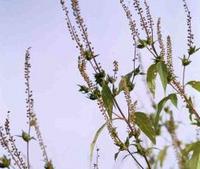 Allergies are often worse for patients during the pollinating season. This is termed seasonal allergic rhinitis SAR. “Hay fever” really is a misnomer, but we tend to use it synonomously with SAR. SAR is caused by pollens, and the most significant in the United States is from ragweed. It begins pollinating in late August and continues until the first frost. Late springtime pollens come from the grasses, such as timothy, orchard, red top, sweet vernal, Bermuda, Johnson, and blue grass. Early springtime hay fever is most often caused by pollens of trees such as elm, maple, birch, poplar, beech, ash, oak, walnut, sycamore, cypress, hickory, pecan, cottonwood, and alder. Colorful or fragrant flowering plants rarely cause allergies because their pollens are too heavy to be airborne. For current and local allergy counts, see Pollen.com.
Allergies are often worse for patients during the pollinating season. This is termed seasonal allergic rhinitis SAR. “Hay fever” really is a misnomer, but we tend to use it synonomously with SAR. SAR is caused by pollens, and the most significant in the United States is from ragweed. It begins pollinating in late August and continues until the first frost. Late springtime pollens come from the grasses, such as timothy, orchard, red top, sweet vernal, Bermuda, Johnson, and blue grass. Early springtime hay fever is most often caused by pollens of trees such as elm, maple, birch, poplar, beech, ash, oak, walnut, sycamore, cypress, hickory, pecan, cottonwood, and alder. Colorful or fragrant flowering plants rarely cause allergies because their pollens are too heavy to be airborne. For current and local allergy counts, see Pollen.com.
 perennial or year-round allergens. When discussing the sinonasal symptoms we term this Perennial Allergic Rhinitis PAR. Symptoms from these are frequently worse in the winter when the house is closed up. Mold spores cause at least as many allergy problems as pollens. Molds are present all year long, and grow outdoors and indoors. Dead leaves and farm areas are common sources for outdoor molds. Indoor plants, old books, bathrooms, and damp areas are common sources of indoor mold growth. Molds are also common in foods, such as cheese and fermented beverages so there may be some cross reactivity. These perennial antigens also seem to cause more congestion, fatigue, and other chronic inflammatory conditions. For more information, see our sections on Food Allergies and Mold and Fungal Allergies.
perennial or year-round allergens. When discussing the sinonasal symptoms we term this Perennial Allergic Rhinitis PAR. Symptoms from these are frequently worse in the winter when the house is closed up. Mold spores cause at least as many allergy problems as pollens. Molds are present all year long, and grow outdoors and indoors. Dead leaves and farm areas are common sources for outdoor molds. Indoor plants, old books, bathrooms, and damp areas are common sources of indoor mold growth. Molds are also common in foods, such as cheese and fermented beverages so there may be some cross reactivity. These perennial antigens also seem to cause more congestion, fatigue, and other chronic inflammatory conditions. For more information, see our sections on Food Allergies and Mold and Fungal Allergies.Mold
Indoors and out, mold spores’ ideal landing pad is one with moisture, air and organic matter to serve as food.
Dust
Dust mites love to dwell in carpeting, furnishings, bedding, radiators, air conditioners and behind and under refrigerators.
Chemicals and Irritants
Irritants evoke inflammation via a non allergic pathway.
More Toxic Troublemakers
Other potential troubles in your home include lead paint, water woes, asbestos, and radon gas.